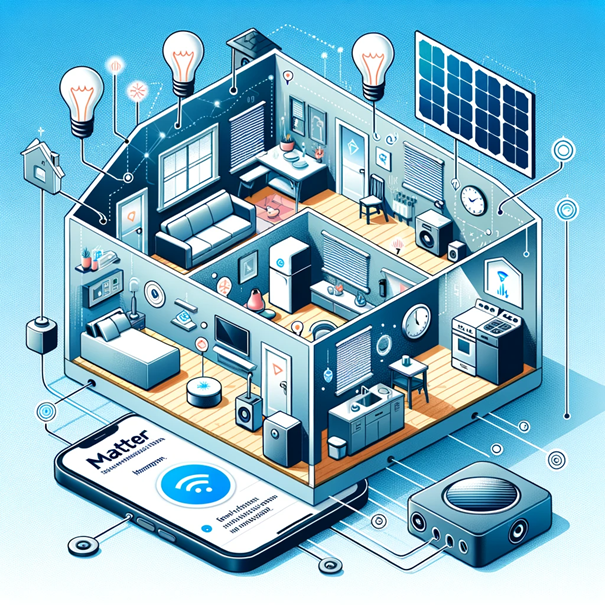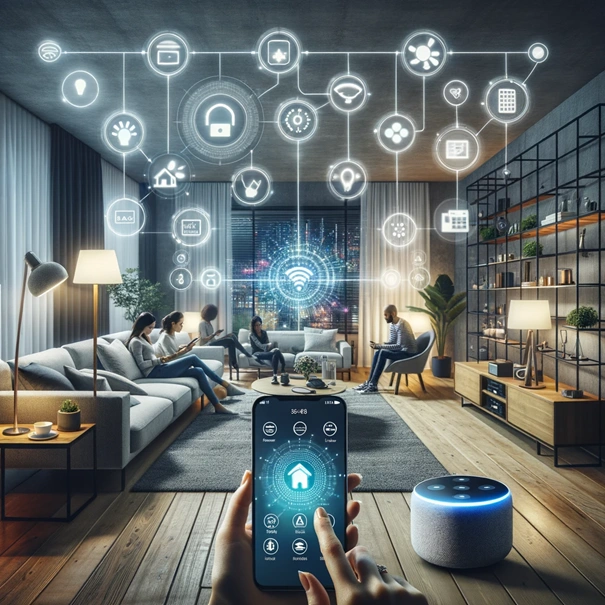Networked devices in the home have become ubiquitous with the Apple Home Kit, Amazon Alexa or Google Home. But the communication technologies used by the individual systems are just as different as the manufacturers. This contradicts the basic idea of the Internet of Things (IoT), which is to network all objects with each other. The new Matter standard, which is being promoted by the major players Google, Apple, Amazon and Samsung, among others, is intended to remedy this situation. Helbling experts are keeping an eye on this trend with the aim of gauging the benefits for customers when it comes to developing solutions and products.
IoT as a driver of sustainability
Smart home systems have a wide range of functions and make it possible, for example, to control products by voice in home automation. Helbling develops innovations in this area for numerous customers, which create decisive market advantages. This also applies to sustainability – an aspect that is becoming increasingly important for society. The possibility to have electronic equipment all communicating with each other, and to be able to remotely control such devices via smart technology (including on your smartphone) offers the potential to optimize overall electricity consumption. This is shown by the following examples:
- Save electricity: The smart home app draws attention to the fact that the radio is on in the apartment even though the residents are away.
- Self-consumption: The dishwasher only starts when there is enough electricity available from your own PV system.
- Passive cooling: The blinds close automatically when the sunlight exceeds a certain intensity.
As an innovation service provider in the smart home sector, it is important for Helbling to identify trends and to deal with the corresponding technologies such as Matter at an early stage. This, especially since the interoperability of devices from different manufacturers has at times been a challenge in terms of implementation, is even more relevant when it comes to household appliances, lighting and air conditioning, including heating, cooling and blinds.
Matter is promising
The Connectivity Standard Alliance (CSA) has set itself the goal of establishing standards in the field of device networking. Launched in 2007 with the first version of ZigBee, it created an important standard in the lighting and energy industry. This is still widely used today in smart home applications such as Philips Hue or the Amazon Echo smart speaker. Although ZigBee is a standard, there are only a few systems that work directly with devices from other manufacturers or manufacturers.
With Matter, the CSA is keen to define a universal device language in the home and thus create a unified ecosystem. Among other aspects, heating, lighting, shading, music and access are taken into account. One benefit here is that a separate gateway or hub is not required for each subsystem. Since it specifies exactly what the features and what the functional scope of a product are, the task becomes easier for system integrators. To ensure that the integration of each device is as seamless as possible, Matter requires each product to be certified and registered. In the field, only tested devices can be integrated into a Matter ecosystem.
Getting there… but still a way to go
After the first Matter release in November 2022, it was expected that various compatible products would be launched in the following months. According to the CSA, certification was issued for several hundred products in the first few months. A detailed analysis has shown that the approved products are mostly light sources and switchable sockets. Why bulbs and sockets? Firstly, as with the ZigBee development, the specification was drawn up based on the lighting (on/off and dimmer) and sample applications were created, which were provided by the chip manufacturers and already pre-certified. These sample applications are suitable for quickly developing compatible and certifiable products. Secondly, and this is the more important point, the lighting sector is one of the most important within the smart home environment.
There is a wide variety of lamps and according to Matter's certification guidelines, each model variant must be separately approved. The associated costs now prevent many companies from offering their products in a Matter-compatible way. On the system integrator side, Google, Apple and Amazon are the pioneers and offer "works with matter" solutions.

The product portfolio is still modest
A look at the roadmap of Matter-compatible devices shows that there are some new products in development. In particular, security technology in relation to doors, gates and windows, as well as climate control technology, for example in the context of thermostats and air conditioning systems, are expected to develop in a dynamic manner. For many appliance categories such as refrigerators, washing machines, ovens, robot vacuum cleaners and heaters, it would appear that the Matter standard is still quite some way off being established.
By means of what are known as "Matter Bridges", some already established smart home providers, such as Philips Hue, have been able to integrate their existing products, which would otherwise not be compatible with Matter technology, into a Matter system.
What does the market need?
If you look at the demo applications, it should be possible in the near future to control the majority of electrical devices in the household via Matter and a single app. Planned use cases show how to use your smartphone to switch on the robot vacuum cleaner while out and about or how to get a notification when the refrigerator door is open. Only time will tell whether this is required by the market and will actively contribute to a purchase decision.
The fact is that the markets have different regional requirements. For example, the functional requirements of a smart door are different in the USA than in Europe. These differently perceived customer needs are exemplified by the Apple Home Kit, which is very clearly oriented towards the needs of the US market. This makes it difficult for European-oriented manufacturers to fully integrate their connected products into the Apple Home Kit. This is not the case with Matter, which is globally orchestrated and democratically developed. If enough interested parties are found for an application, it will be taken into account when developing new features for future versions of Matter.
When will Matter become the standard?
Today's Matter standard still has some gaps in terms of the range of potential applications. Expanding the array of functions or supported product categories is a lengthy process. In addition to the Matter specification, test plans and tools for the certification program must also be created and sample applications must be made available in the form of a software development kit (SDK). Once the specification has been approved, it takes a long time for the development and certification of the products to be implemented. However, the chances are that we will be surrounded by Matter-enabled devices in a few years. It is not yet clear whether Matter will emerge as a recognizable product feature for the customer, such as Bluetooth or WiFi, or whether it will remain a standard used in the background that the customer sees as being advertised as "compatible with...".
What does Matter offer on the technical side?
In addition to standardizing the so-called clusters, the Matter standard also fulfills a valuable task of standardizing picking and communication within a so-called fabric (for further information, please refer to the Factbox below).
In terms of future compatibility and security with the Matter standard, it is important that each device comes with something known as a Private Key that meets Matter's requirements. For example, Matter demands that the Private Keys are generated by means of a Deterministic Random Bit Generator and a True Random Number Generator according to nist.gov.
According to Matter, if these requirements are implemented, the same concepts can also be used for cloud device provisioning services such as this one.
Summary: Matter integration requires intensive clarification
Regardless of whether a manufacturer decides to fully implement the Matter standard, it may make sense to use the concepts of the standard for two reasons. Firstly, this ensures future compatibility with the Matter standard, and secondly, it guarantees the security of the system by using proven concepts. However, it is not worthwhile for all applications to undertake the complex process towards Matter compatibility. Helbling experts are on hand to clarify the potential. And if a company decides to pursue this path, Helbling not only supports the development process, but can also help with the certification by offering the appropriate infrastructure.
Authors: Lukas Wilhelm, Aaron Riedener
Main Image: DALL-E




